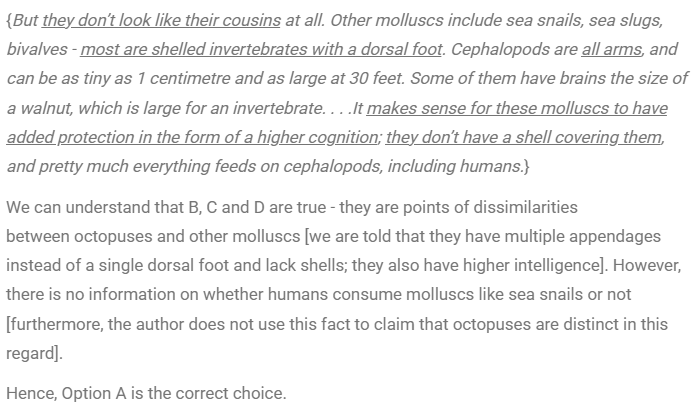CAT RC Questions | CAT RC Based on Natural Science questions
FundaMakers is the Best CAT Online Coaching In India. Now prepare for CAT anytime with FundaMakers. We provide well-ordered syllabus coverage for both offline and online CAT preparation batches. FundaMakers brings to you the power-packed, well-structured CAT previous year question bank with more than 4000+ CAT Past Year questions. In the VARC section, one of the most frequently asked questions is from the topic- Reading Comprehension. Reading Comprehension turns out to be an important part of the VARC section from which over 60-70% of the questions are based on RC in the CAT Exam.
FundaMakers as a team has taken a painstaking step to bring you all the video solutions of the Reading Comprehension asked in the Previous Year CAT exam. CAT question bank offered by FundaMakers is a power-packed topic-wise compilation of the entire CAT previous year questions. Questions from the Reading Comprehension topic are some of the most scoring questions in the VARC section. To maximize your CAT score make use of FundaMakers CAT Question Bank. “Questions from CAT previous years” examination papers have been incorporated. Let’s get started with CAT Past Year Reading Comprehension Questions.
Comprehension
The passage below is accompanied by a set of questions. Choose the best answer to each question.
[Octopuses are] misfits in their own extended families . . . They belong to the Mollusca class Cephalopoda. But they don’t look like their cousins at all. Other molluscs include sea snails, sea slugs, bivalves – most are shelled invertebrates with a dorsal foot. Cephalopods are all arms, and can be as tiny as 1 centimetre and as large at 30 feet. Some of them have brains the size of a walnut, which is large for an invertebrate. . . . It makes sense for these molluscs to have added protection in the form of a higher cognition; they don’t have a shell covering them, and pretty much everything feeds on cephalopods, including humans. But how did cephalopods manage to secure their own invisibility cloak? Cephalopods fire from multiple cylinders to achieve this in varying degrees from species to species. There are four main catalysts – chromatophores, iridophores, papillae and leucophores. . . . [Chromatophores] are organs on their bodies that contain pigment sacs, which have red, yellow and brown pigment granules. These sacs have a network of radial muscles, meaning muscles arranged in a circle radiating outwards. These are connected to the brain by a nerve. When the cephalopod wants to change colour, the brain carries an electrical impulse through the nerve to the muscles that expand outwards, pulling open the sacs to display the colours on the skin. Why these three colours? Because these are the colours the light reflects at the depths they live in (the rest is absorbed before it reaches those depths). . . . Well, what about other colours? Cue the iridophores. Think of a second level of skin that has thin stacks of cells. These can reflect light back at different wavelengths. . . . It’s using the same properties that we’ve seen in hologram stickers, or rainbows on puddles of oil. You move your head and you see a different colour. The sticker isn’t doing anything but reflecting light – it’s your movement that’s changing the appearance of the colour. This property of holograms, oil and other such surfaces is called “iridescence”. . . . Papillae are sections of the skin that can be deformed to make a texture bumpy. Even humans possess them (goosebumps) but cannot use them in the manner that cephalopods can. For instance, the use of these cells is how an octopus can wrap itself over a rock and appear jagged or how a squid or cuttlefish can imitate the look of a coral reef by growing miniature towers on its skin. It actually matches the texture of the substrate it chooses. Finally, the leucophores: According to a paper, published in Nature, cuttlefish and octopuses possess an additional type of reflector cell called a leucophore. They are cells that scatter full spectrum light so that they appear white in a similar way that a polar bear’s fur appears white. Leucophores will also reflect any filtered light shown on them . . . If the water appears blue at a certain depth, the octopuses and cuttlefish can appear blue; if the water appears green, they appear green, and so on and so forth.
CAT/2022.2
Question . 22
All of the following are reasons for octopuses being “misfits” EXCEPT that they:
Explanatory Answer
Method of solving this CAT RC Question from RC Based on Natural Science question
Correct Option: A

Hey!
Worried about IIM calls due to your marks in 10th,12th, and Graduation?
Don't worry! Know your chances of getting an IIM Call based on your profile with our:-
Profile Professor: https://fundamakers.com/profile-professor/

5 Must- NOT-Dos during CAT Preparation.
- Do not treat CAT as 'Everything'.
- Do not quit your job for CAT exam preparation.
- Learning till The Eleventh hour instead of doing proper revision.
- Not checking the syllabus thoroughly.
- Piling up multiple books.
Click To Read:- Common mistakes made by CAT aspirants during preparation.
FundaMakers- Best Online and Offline CAT Online Preparation Institute in India
For any CAT Preparation related query, reach out to us at 9598333344.